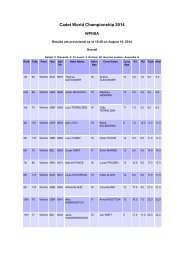NGA_AR_13-14
NGA_AR_13-14
NGA_AR_13-14
You also want an ePaper? Increase the reach of your titles
YUMPU automatically turns print PDFs into web optimized ePapers that Google loves.
East Asian acquisitions include a group of boys’<br />
kimonos from 1920s–40s Japan emblazoned<br />
with graphics related to war, including cannons,<br />
battleships, tanks and soldiers as symbols of<br />
Japanese patriotism. The textiles are part of a<br />
commitment to developing the collection of<br />
children’s clothing from across Asia.<br />
An exceptional pair of high-quality 1860s travel<br />
albums of views and portraits of British India by<br />
Bourne and Shepherd and other leading studios<br />
augmented the Gallery’s significant collection of<br />
photography in the region. Pioneer British travel<br />
photographer Samuel Bourne is represented<br />
by a range of loose prints suitable for wall<br />
display, and the pair of albums are essential for<br />
a future exhibition of Bourne and Shepherd’s<br />
work. A number of gaps in genres included in<br />
the exhibition Garden of the East: photography<br />
in Indonesia 1850s–1940s led to acquisitions of<br />
historical works by European photographers at<br />
work in the Dutch East Indies, including four<br />
major albums by German-born Tassilo Adam and<br />
two unusually large exhibition prints by Swiss<br />
photojournalist Gotthard Schuh. Asia–Pacific<br />
Pictorialism has been an area being developed for<br />
some years, and the acquisition of a group of 1920s<br />
prints by Arthur de Carvalho, working in China<br />
and Bali in the 1920s and 1930s, gave considerable<br />
strength to that collection. Work by contemporary<br />
Indonesian photomedia artists FX Harsono,<br />
Mella Jaarsma and Melati Suryodarmo were<br />
also acquired.<br />
There were a number of gifts of historical and<br />
contemporary work. The American Friends of<br />
the National Gallery of Australia presented a<br />
group of works by various Asian and Australasian<br />
photographers from between the 1880s and<br />
1940s, most of which had been included in the<br />
2008 exhibition Picture paradise: Asia–Pacific<br />
photography 1840s–1940s as loans from collector<br />
David Knaus. Collector Peter Lee of Singapore<br />
presented two works and collaborating artists<br />
Jon Anderson and Edwin Low presented two<br />
digital portrait studies from their 2010 series<br />
Manga dreams.<br />
International art<br />
Nine modern and contemporary sculptures were<br />
acquired for the international collection this year,<br />
including Head and bird (Tete et oiseau) 1981,<br />
an intriguing and haunting bronze by the famous<br />
Surrealist artist Joan Miró. His assemblages, made<br />
in the spirit of Picasso, were constructed using all<br />
kinds of collected objects, elements of wood and<br />
iron, and subsequently cast in bronze. The work<br />
was purchased through the Tony Gilbert AM<br />
Bequest Fund.<br />
Anthony Caro’s sandstone and steel Duccio<br />
variations no 7 2000 was a gift from the American<br />
Friends of the National Gallery of Australia, made<br />
possible with the generous support of Kenneth<br />
Tyler AO and Marabeth Cohen-Tyler. Inspired<br />
by a painting in the National Gallery, London,<br />
it represents the career of this important British<br />
artist. Caro’s paper sculpture #4 Big white 1982 was<br />
a gift from Penelope Seidler AM.<br />
A recent installation by Jessica Stockholder,<br />
Buff ambit 2006, reveals her extraordinary<br />
combination of banal and strange objects into<br />
a carefully composed and tiered sculpture that<br />
steps out from the wall.<br />
The Gallery purchased six light works by the<br />
contemporary American artist James Turrell.<br />
Joecar (red) 1968 is an early projection piece and<br />
Shanta II (blue) 1970 uses projected light set into<br />
the wall, causing the viewer to perceive an object<br />
floating within the gallery. The construction of<br />
a light-infused void for Orca 1984 makes a ‘fog’<br />
or ‘veil’ of light, which the artist compares to the<br />
experience of ‘flying blind’. After green 1993/2003<br />
brings together fibre-optic, LED and fluorescent<br />
lights to develop an immersive environment.<br />
Bindu shards 2010 contains and isolates a single<br />
person in a sphere for an intense fifteen-minute<br />
cycle and has been likened to a three-dimensional<br />
bodily kaleidoscope. Dark matters 2011, one of<br />
Turrell’s most demanding works, removes light<br />
from the experience altogether and subjects the<br />
viewer to a meditative space in which he or she<br />
may perceive an internal light. In addition, the<br />
Gallery purchased, through the Poynton Bequest<br />
Fund, Turrell’s portfolio First light 1989–90 of<br />
seven etchings and aquatints.<br />
The Gallery continued to acquire works through<br />
the Poynton Bequest Fund, named after the late<br />
Orde Poynton AO, CMG. William Kentridge’s<br />
portfolio of watermarked drawings Sheets of<br />
evidence 2009, Anish Kapoor’s suites of etchings<br />
Shadow V 20<strong>13</strong> and History 2007 and Grayson<br />
NATIONAL GALLERY OF AUSTRALIA ANNUAL REPORT 20<strong>13</strong>–<strong>14</strong> 41



